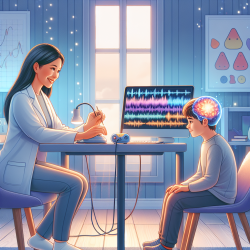Introduction
Potocki-Lupski Syndrome (PTLS) is a rare genetic disorder characterized by a duplication of chromosome 17 band p11.2. This condition can lead to a variety of congenital abnormalities and behavioral phenotypes, including developmental delays and intellectual disabilities. Autism Spectrum Disorder (ASD) traits are often reported among PTLS patients, making it crucial for practitioners to understand the potential overlap between these conditions.
Key Findings from Recent Research
A recent study by Talantseva et al. (2023) explores the presence of ASD traits in PTLS patients. The research includes a detailed case study of a female adolescent with PTLS who did not exhibit ASD features, despite undergoing comprehensive clinical, behavioral, and electrophysiological evaluations. Notably, the study highlights atypical EEG patterns, such as peak-slow wave patterns and a unique saw-like sharp wave, which were not previously documented in PTLS patients.
Implications for Practitioners
Practitioners working with PTLS patients should consider the following insights from the study:
- ASD Traits in PTLS: The occurrence of ASD traits in PTLS patients is estimated to be around 21%, which might be biased due to methodological limitations. Practitioners should be cautious in diagnosing ASD in PTLS patients and consider comprehensive assessments.
- Focus on Speech and Language Disorders: The study suggests that speech and language disorders might play a more central role in the PTLS phenotype than ASD. Practitioners should prioritize speech and language evaluations and interventions.
- EEG Patterns: The unique EEG patterns observed in PTLS patients could serve as a diagnostic tool. Practitioners should consider EEG evaluations to better understand the neurological underpinnings of PTLS.
Encouraging Further Research
While this study provides valuable insights, it also highlights the need for further research. Practitioners are encouraged to explore the following areas:
- Longitudinal Studies: Conducting longitudinal studies on PTLS patients could provide a deeper understanding of the progression of ASD traits and other behavioral phenotypes.
- Standardized Diagnostic Criteria: There is a need for standardized diagnostic criteria for ASD in PTLS patients to ensure accurate diagnosis and intervention.
- Genetic and Neurological Correlates: Further research into the genetic and neurological correlates of PTLS could lead to more targeted therapies and interventions.
Conclusion
The study by Talantseva et al. (2023) offers significant insights into the relationship between PTLS and ASD. By focusing on speech and language disorders and utilizing EEG evaluations, practitioners can enhance their understanding and treatment of PTLS patients. As the field of genetic disorders and autism continues to evolve, ongoing research and collaboration among practitioners will be essential in improving outcomes for individuals with PTLS.
To read the original research paper, please follow this link: Does the Potocki–Lupski Syndrome Convey the Autism Spectrum Disorder Phenotype? Case Report and Scoping Review.










